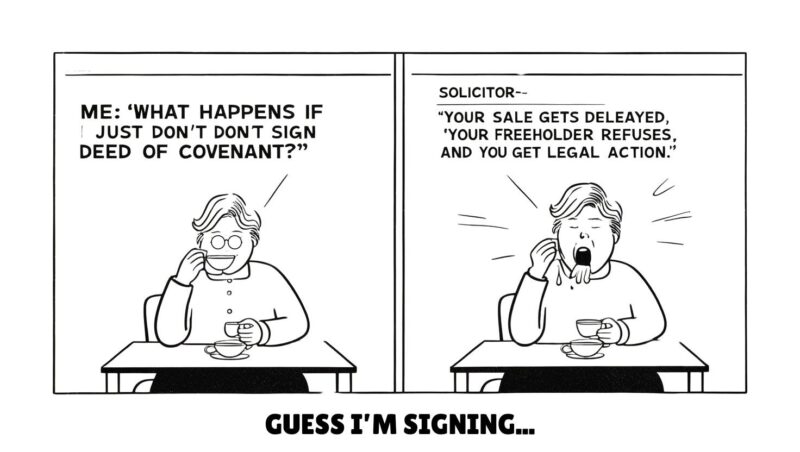What Is a Deed of Covenant? Explained for Homebuyers
A Deed of Covenant is a legally binding agreement in property transactions, most commonly required in leasehold sales. It ensures that the new owner complies with service charges, property maintenance, and lease restrictions set by the freeholder or management company. If your lease requires one, failing to sign could delay or even block your sale, making it essential to understand how they work.
Key Takeaways:
- A Deed of Covenant is often required in leasehold transactions to ensure the buyer follows lease obligations.
- Costs typically range between £150-£300, and buyers are usually responsible for the payment.
- Failure to sign or comply with a Deed of Covenant can lead to delays, fines, or legal disputes.
-
- What Is a Deed of Covenant?
- When Is a Deed of Covenant Required?
- What Does a Deed of Covenant Cover?
- Types of Covenants in a Deed of Covenant
- Do I Have to Sign a Deed of Covenant?
- How Much Does a Deed of Covenant Cost?
- What Happens If You Breach a Deed of Covenant?
- Can You Remove or Change a Deed of Covenant?
- Struggling with Leasehold Restrictions? Sell Without the Hassle
- Frequently Asked Questions
What Is a Deed of Covenant?
A Deed of Covenant is a legally binding agreement between a leaseholder and a freeholder or management company, ensuring that the new owner agrees to follow the obligations set out in the lease. It is typically required when a leasehold property is sold or transferred to confirm that the new owner will continue paying service charges, maintaining communal areas, and adhering to any property restrictions.
Who Needs to Sign a Deed of Covenant?
The following parties may be required to sign a Deed of Covenant:
- Leaseholders buying or transferring ownership of a leasehold property.
- Freeholders or management companies enforcing lease obligations.
- Buyers of leasehold properties where the lease states a Deed of Covenant must be signed before completion.
This is what a deed of covenant looks like:
When Is a Deed of Covenant Required?
A Deed of Covenant is typically needed in leasehold property transactions to ensure that the new owner complies with the lease terms. The most common situations where it is required include:
- When a leasehold property is sold or transferred, ensuring the buyer agrees to the existing obligations.
- If the lease states that a Deed of Covenant must be signed upon transfer or assignment.
- When the freeholder or management company requires it before accepting the new leaseholder.
For freehold properties, a Deed of Covenant is rarely required unless a covenant was imposed in a previous transfer agreement. In such cases, buyers should review the title deeds to check for any existing restrictions.
According to Gov.uk, as of 2021-22, there were approximately 4.98 million leasehold dwellings in England, making up around 20% of the housing stock. This highlights the prevalence of leasehold properties and the importance of understanding Deeds of Covenant in property transactions.
What Does a Deed of Covenant Cover?
A Deed of Covenant outlines the responsibilities and restrictions that a leaseholder must follow as part of their lease agreement. These covenants protect the freeholder or management company and ensure that all leaseholders maintain the property and meet financial obligations.
While the specific terms vary from lease to lease, they typically fall into the following categories:
Common Obligations in a Deed of Covenant
| Category | Typical Obligations |
|---|---|
| Financial | Paying service charges, ground rent, and maintenance fees |
| Property Maintenance | Keeping the property and communal areas in good condition |
| Usage Restrictions | No subletting, commercial use, or major alterations without consent |
| Behavioural Restrictions | No pets, limits on noise levels from bad tenants, and restrictions on disruptive activities |
Since every lease has unique terms, reviewing the Deed of Covenant carefully before signing is crucial. Some covenants can be negotiated with the freeholder, but ignoring or breaching them can lead to legal disputes or financial penalties.
Types of Covenants in a Deed of Covenant
Covenants in a lease are generally divided into two types: Positive Covenants and Negative Covenants. These define the responsibilities and restrictions that a leaseholder must adhere to.
Positive Covenants
These require the leaseholder to take specific actions to maintain the property and shared spaces. Examples include:
- Paying service charges promptly.
- Contributing to maintenance and repair costs.
- Keeping communal areas in good condition.
- Agreeing to major works (e.g., roof repairs or external renovations).
Negative Covenants
These restrict leaseholders from taking certain actions that could impact the property or its residents. Examples include:
- No pets: Some leases prohibit animals in the building.
- No subletting: Renting out the property may be restricted.
- No commercial use: Running a business from the property may not be allowed.
- Noise restrictions: Leaseholders may need to limit noise after certain hours.
Related Read: How to sell your tenanted property fast
Do I Have to Sign a Deed of Covenant?
In most cases, yes - if the lease specifies that a Deed of Covenant is required, the buyer must sign it before completion. Without it, the freeholder or management company may refuse to recognise the new leaseholder.
What Happens If You Don’t Sign?
- Delays in selling the property: The transaction cannot be completed until the deed is signed.
- Freeholder may refuse service charge payments: This can lead to financial penalties and accumulation of unpaid fees.
- Legal consequences: The freeholder may take legal action to enforce compliance, which could result in court proceedings.



